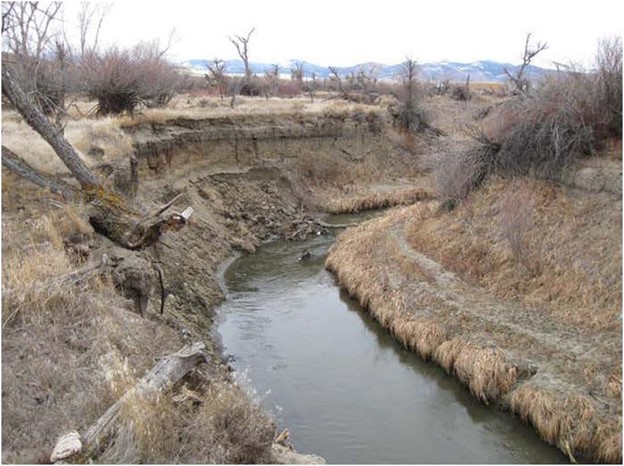
Overall extensive human activities have changed the character of the Big Pipestone channel near what is now the Interstate 90 crossing. With the advent of trapping, the beaver was removed from the stream system. In late 1800s, the building of the railroad straightened a significant portion of Big Pipestone Creek. In the late forties, the stream reach on the Capp Ranch was straightened another portion the creek. This immediately began a series of head cuts which have left significant portions of the creek cut to a depth of 15 to 20 feet causing a huge sediment deposit in Big Pipestone Creek. This resulted in:
- Becoming the second highest sediment load in a Montana stream, with approximately7,900 tons of sediment sent down stream annually
- Aggravating flooding in Whitehall,
- Loss of agricultural land, loss of access to permitted irrigation water
- Filling in of the Jefferson Slough with sediment which provides a perfect nursery for the growth and spread of Eurasian Water Milfoil, an invasive aquatic weed, which now threatens the Upper Missouri River basin.
Work began on Pipestone Creek & the Jefferson Canal in 2014. The following lists the projects completed to date and those now underway.
U.S. Forest Service Trail Maintenance and Erosion Mitigation Projects
In 2014The United States Forest Service (USFS) completed trail maintenance work on several high
priority stream crossings on the Big Pipestone Creek drainage on USFS lands.
Jefferson Canal Headgate Replacement
The inability to regulate the flows from the canal back into Big Pipestone Creek created a large blowout on Big Pipestone Creek in turn creating massive sediment flows into Big Pipestone Creek at the junction of the Jefferson Canal return flows into the creek. Before the Jefferson Canal blowout on Big Pipestone Creek could be addressed the Jefferson Canal headgate needed to be replaced
Jefferson Canal Blowout Stabilization
The inability to regulate the flows from the canal back into Big Pipestone Creek created a large blowout on Big Pipestone Creek in turn creating massive sediment flows into Big Pipestone Creek at the junction of the Jefferson Canal return flows into the creek. The Jefferson Canal Blowout was restored and seeded in 20
Town of Whitehall Flooding Projects
n the late 1980’s a floodplain study by the then Soil Conservation Service identified that high sediment loads in Big Pipestone Creek in the town of Whitehall were creating increased flooding in the town during high runoff years. In the 2012 Watershed assessment identified that in addition to the necessary stream restoration projects ups stream of Whitehall three (3) projects on the East side of Whitehall were necessary to address the flooding issue in Whitehall. Those projects were:
- Removal of a stream diversion on the Dave Smith Ranch
- Replacement of the Kountz road bridge,
- Removal of sediment under a Montana Rail Link stream crossing.
All the projects were completed in 2015, 2016 and 2017.
Capp Ranch Big Pipestone Creek Stream Restoration Project
The Capp Ranch worked with Jefferson County, and the Jefferson River Watershed Council to develop two strategies for reducing the sediment deposition in Big Pipestone Creek in the Town of Whitehall and the Jefferson Slough. A design plan for relocation of Big Pipestone Creek in its historic channel or the development of an inset flood plain in the degraded channel have both been completed. The Capp Ranch has declined to implement either of the plans. The Capp Ranch is the only landowners that have declined to work with the program.
Kountz Riparian Improvements
In the fall of 2014, John Kountz implemented a project on Big Pipestone Creek which installed 1700 feet of fencing protecting 12 acres of riparian area in combination with creating a hardened stream crossing and two large pastures under separate grazing strategies.
Smith Ranch Riparian Improvements
Projects scheduled to be carried out in 2020 & 2021 include:
Stabilization of 315 feet of eroding banks using a combination of bioengineered and hard treatments,
• Installation of 2 water gaps and one hardened channel crossing to limit livestock access to focused areas,
• Installation of 4835 feet of riparian fencing (3255 feet of barbed wire and 1580 feet of post and rail)
• Installation of two off-channel livestock watering systems, which include two solar powered wells and nine stockwater tanks.
• TBD – planting woody vegetation along riparian corridor within fenced areas (quantities currently unknown).